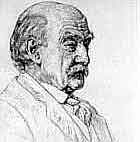ABOUT JERICHO - ARTS ITEM
Thomas Hardy in Jericho

Clement Shaw on Jericho's role in Jude the Obscure
Posted - June 05, 2002When Hardy’s fictional Jude arrives in ‘Christminster’ he lodges “on inexpensive terms in the modest type of accommodation he demanded; and after inquiry took a room in a suburb nicknamed Beersheba”. Christminster was Oxford and it’s not unfanciful to speculate that the suburb was Jericho, and that our very own Jude the Obscure hostelry in Walton Street is not a stone’s throw from his modest room.
Thomas Hardy’s masterpiece is the story of a young man of working-class origin, born in an obscure country town, who acquires a passion for art, culture and scholarship. Largely through growing up close to Oxford—yet at a sufficient distance from it—he is thrilled and inspired by the architecture of its colleges and churches and is exalted beyond reason by a pathetically idealised conception of Oxford as a place for all that is finest in culture and scholarship.
Jude’s struggles to reach his goal, entry into the University and a scholar’s life, are the main theme of the novel. Its tragedy is the cruel, embittering failure of all his efforts, and the bleak unredeemed wretchedness of his lonely and all-too-obscure end.
Though Hardy denied it, Jude surely is a uniquely personal work. We know he was articled to the architect and church restorer John Hicks in Dorchester at 16. In the period 1862-67 Hardy was assistant architect to Arthur Blomfield who was commissioned by Thomas Combe to design the church of St Barnabas. Thomas and Martha Combe were devotees and patrons of the Pre-Raphaelite Brotherhood and members of the Tractarian Movement. They gave Blomfield a free hand “that it should be large enough for a thousand worshippers, sound in construction and the interior dignified. Nothing was to be wasted on external appearances”. The church, which was to be Romanesque in style after the cathedral of Torcello near Venice, was completed in 1869.
Jude the Obscure was published thirty years later when Hardy was 58. The novel makes many references to the Tractarians and the influences they had on Jude. What, we may wonder, were the influences on Hardy so many years before, working in Jericho on such a remarkable building with such remarkable men? Who was the fussy, snobbish parson who tells Jude to go back to his work as a builder’s labourer and not bother with matters ‘beyond him’?
Whoever it was, Jericho and St Barnabas surely inspired one of the great passionate English novels. Even today the book is an indignant plea for making available to plain men, women and children (especially children) all the sources of joy and enrichment of life which cannot be “weighed and measured” by accountants in a ledger.
Author: Clement Shaw
The origins of Nelson Street?
Nelson Street takes its name from a local pub, the Lord Nelson, subsequently renamed Carpenters’ Arms -- which has since been converted to housing.
How religious we are?
In the 2001 Census, some 50% of Jericho residents said they were Christian, 2.2% Muslim, 1.9% Buddhist and 1.2% professed other religions, while 34% of people said they had no religion. In Oxford as a whole the proportion with no religion was 24%.